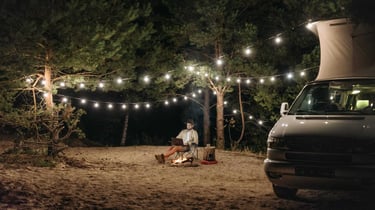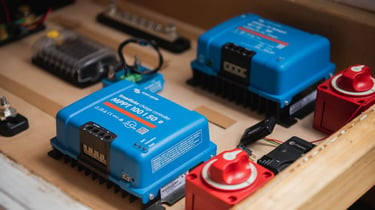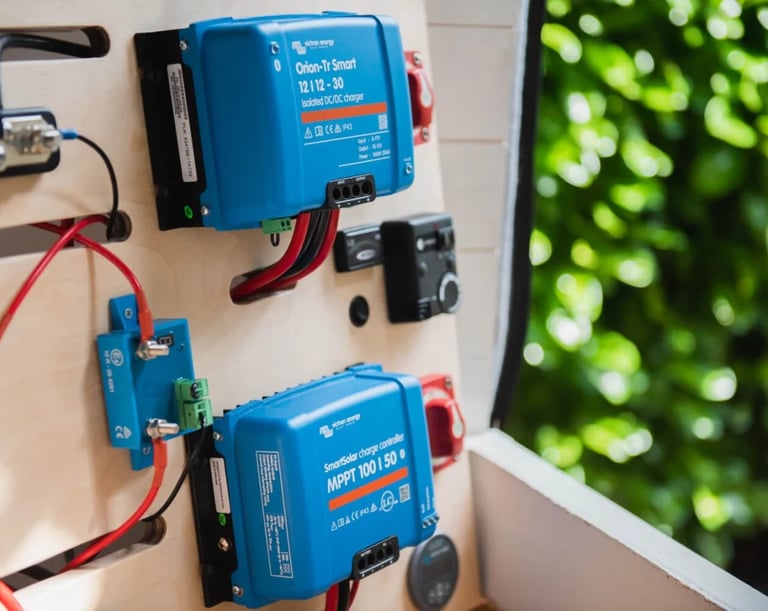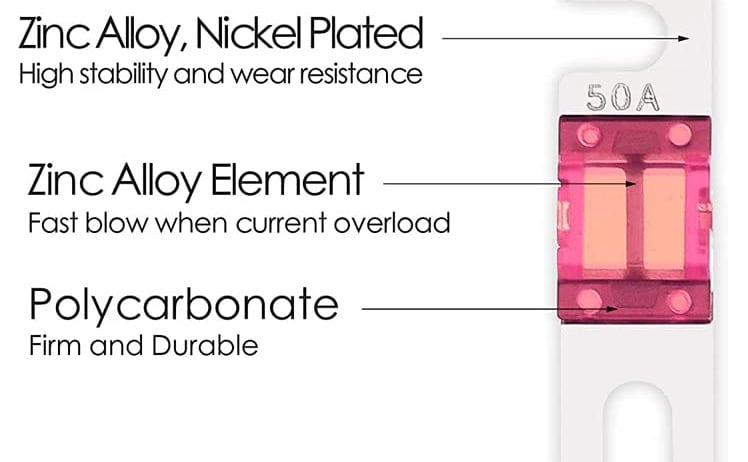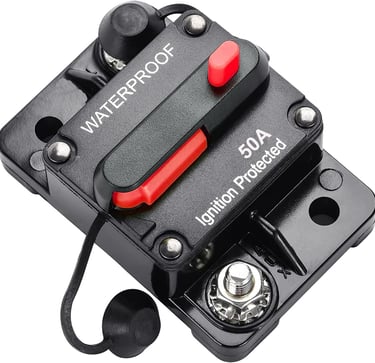Luxurious Vanlife Without Compromise – 600Ah+
If you’re aiming for all the comforts of home, including air conditioning, induction cooking, water heating, and heaters, you’ll need at least 600Ah of battery capacity. This setup is perfect for high-energy use and essential for vanlifers spending winters in low-sunlight regions.
To efficiently use such a system, you’ll need robust charging options: a generator, ample solar panels, and land power hookups when available.
Recommended Batteries:
200Ah LiFePO4 Battery (24V)
2 How to Recharge Your Camper Van Batteries
Running out of power on the road is every vanlifer’s nightmare. To avoid this, diversify your recharging options.
We recommend having all three methods for full-time vanlifers:
Solar Power
Generator Charging
Shore Power
Solar Power – The Holy Grail of Off-Grid Van Life!
A detailed energy budget helps you determine how much solar power you need to supply your camper van’s batteries with sufficient electricity.
But here’s a quick tip: it pays to maximise the size of your solar panels during installation to save future hassle.
For systems exceeding 300W, upgrade from small 100W panels to 175W, 200W, or even larger options. On our camper van, Rover, we use two 370W residential-grade solar panels. Larger panels simplify wiring and installation and let’s face it, you might even squeeze more panels onto your roof. Trust us you’ll thank yourself later! Keep in mind that sourcing large panels might be tricky, and maximising solar power may reduce roof storage space. Plan your roof layout wisely.
DC-DC Charging via Your
Vehicle’s Alternator
You can charge your camper van’s batteries while driving with a DC-DC charger. Think of this as "FREE" power since you can plan your journeys to ensure fully charged batteries even when sunlight falls short. It’s always smart to maximise your power sources, especially in winter, when days are shorter.
For example, the Victron Energy Orion-Tr Smart 12/12 18A charger can deliver 18A of 12V-to-12V power. Be cautious about underpowered chargers, especially if you’re not using solar panels.
One DC-DC Charger:
If you’re a “weekend warrior” with a smaller electrical system
If you have 200Ah or fewer lithium batteries
If your vehicle’s alternator is 160A or smaller
Two DC-DC Chargers:
If you’re a full-time vanlifer or enjoy luxury van life
If you have over 200Ah lithium batteries
If your vehicle has two starting batteries or a powerful alternator
Shore Power with an Inverter Charger
You can use an inverter charger to power your batteries with shore power. Here are our top models:
Victron Multiplus C 12V, 2000W, 80A-50A Inverter Charger:
Lightweight at only 11kg!
Simple AC outlet
Charges 12V batteries up to 960W (80A)
Victron Multiplus II 12V, 3000W, 120V-50A Inverter Charger:
Slim design, weighs 22kg
Dual 50A AC outlets
Charges 12V batteries up to 1440W (120A)
Ways to Use Your Campervan House Batteries (DC vs AC Power Consumption)
In simple terms, you can use your camper van’s house batteries in two ways: through 12V (or 24V) Direct Current (DC) or 120V Alternating Current (AC).
Keep in mind that 120V is standard in the US/Canada, whereas many European countries use 220V. Verify your country’s AC power standard before starting your build!
DC Appliances in a Camper Van
DC power is the backbone of any off-grid camper van electrical system! It powers almost everything fixed in your setup. DC appliances are more efficient than converting power to AC, so aim to run as many as possible on direct current.
A self-sufficient camper van should ideally rely solely on DC power (looking at you, AC mini fridges!) to avoid keeping the inverter on 24/7. Inverter self-consumption can be surprisingly high (10–30W depending on the model), so turning it off whenever possible saves a significant amount of energy.
Common DC Power Loads:
Water pump and valves
Gas heater
Reading light, LED
AC Appliances in Your Camper Van
While a van can run entirely on DC power, incorporating AC appliances brings a world of convenience, making vanlife feel even more like home. AC power supports everything you’d plug into a household outlet:
Electric kettle
Induction Cooktop
Blender
Laptop charger
A Guide to Efficient Energy Use
When designing your campervan’s electrical system, one of the biggest decisions is whether to prioritise a 12V system or rely on AC power. While appliances powered by AC are often cheaper because they’re less specialised, 12V devices, such as 12V fridges designed for boats, trucks, and campervans, are generally more efficient and tailored for off-grid living.
Our System: 12V
In our basic campervan, we rely almost entirely on a 12V system. Our lights, diesel heater, and multiple cigarette lighter sockets all run on 12V. When plugged into shore power, our battery charger replenishes our leisure battery. We also have a split charging system, but it’s not always in use, and we haven’t installed solar panels yet.
When on shore power, we use three AC outlets:
One powers my battery charger.
The other two handle high-energy appliances that our battery bank cannot support, such as an electric fan heater or a hot plate for cooking. For most cooking, we typically use a traditional alcohol stove/burner.
Why Stick to 12V?
Whenever possible, sticking to 12V for your campervan’s electrical system is the most efficient option.
Here’s why:
Energy Efficiency: Voltage conversion from DC to AC causes energy loss, typically around 20–25%. Even high-quality inverters with 85% efficiency waste energy. For instance, running a 1200Wh load through an inverter would require over 1400Wh of battery capacity. Sticking to 12V requires only 1200Wh for the same load.
Safety: Working with 12V wiring is safer and simpler than handling 240V AC systems, especially in vehicles. When plugging into shore power occasionally, using converters properly and safely is essential.
USB Power Loss: USB charging for devices can also be inefficient. High-quality USB chargers are up to 80% efficient, whereas cheaper ones are often around 50%. Sticking to your battery bank’s native voltage is the most efficient route.
Should You Choose a Modified or Pure Sine Wave Inverter?
The short answer: A pure sine wave inverter is always better than a modified sine wave—it can run all types of electronic devices. However, pure sine wave models are slightly more expensive, and a modified sine wave may suffice in some cases.
Here’s the breakdown:
Why Pure Sine Wave Is a Safe Bet: Pure sine wave is the same type of power found in homes, whereas modified sine wave produces a “square” current.
Key Differences: Pure sine wave inverters can run virtually all devices, while modified sine wave inverters struggle with specific equipment and, in the worst case, may even damage them.
Devices That Don’t Work Well with Modified Sine Wave:
Stereo/Hi-Fi systems—audio quality suffers
Most modern electronics (e.g., computers and TVs)—risk of damage
Summary: Efficient Energy Use in Your Campervan
Safety First: Stick to 12V whenever possible, it’s safer and simpler than mains voltage
Keep It Simple: Build your system with 12V appliances for maximum efficiency and safety
Minimise Converter Use: Every time you convert power, you lose energy. Use an inverter only for appliances that require it
Think Long-Term: Investing in high-quality components like inverters and USB sockets saves energy and frustration over time
By understanding the trade-offs between 12V and AC power, you can design an energy system that meets your needs while keeping your campervan efficient, safe, and ready for adventures.
When purchasing an inverter, always choose a pure sine wave model. It works with far more devices, ensuring your gadgets remain safe. While a modified sine wave inverter may suffice for basic tasks like phone charging, who knows what devices you might want to connect in the future?



